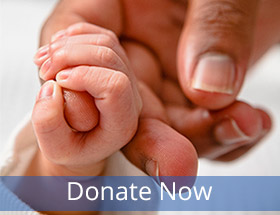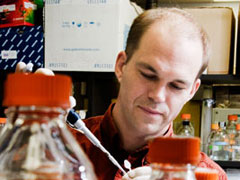Better to Receive
By Laura Pratt
An Fc receptor is kind of like the perfect matchmaker at a party, flitting about the place in diaphanous wonder, making introductions, launching stimulating conversations, facilitating relationships. For the most part, the liaisons this go-between engenders are positive ones. Sometimes, though, they’re toxic, and the unions are troubled from the get-go. Dr. James Booth, a molecular and cellular biologist at Sunnybrook Research Institute, is endeavouring to understand the nature of the relationships into which Fc receptors insinuate themselves. And he’s recently been awarded a $575,000 grant from Canadian Institutes of Health Research to buy him a ticket to the festivities.
Specifically, Booth is studying the molecular details of how white blood cells use Fc receptors, proteins which sit on the surface of certain of these cells, to bind and engulf foreign material that has been coated by antibodies. Fc receptors let white blood cells recognize foreign material that antibodies have attached to, which they then destroy and to which they set up protective inflammatory responses. While this recognition process is important for allowing white blood cells to work in conjunction with antibodies to fight infection, Fc receptors can also trigger tissue-damaging inflammatory responses to self-reactive antibodies, present in those suffering from autoimmune diseases including lupus and rheumatoid arthritis.
And so it is that, in some cases, like an infection, you want to boost the activity of Fc receptors and in other cases, like autoimmune disease, you want to damp it down. “They have a good and bad side,” says Booth of the darlings of his research. “They’re mostly good. You’d rather have these receptors than not. It’s only when other things have gone wrong and you have autoimmunity already that they contribute to making the problem worse. Then you have these self-reactive antibodies that they glom on to, but the receptors don’t know that they’re bad.”
Booth is determined to put all this in order in the hope that a better appreciation of these receptors’ workings may allow their exploitation to the good: to either harness their function to give better response against infectious diseases in the context of designing vaccines, or to block their signalling as a way to alleviate symptoms in autoimmune conditions.
“One of the interesting things about Fc receptors,” Booth says, “is that antibodies are central to immune responses, so understanding the basic biology of Fc receptors well enough to manipulate their function could be useful down the road in several very different clinical contexts.”
The grant—a renewal of the grant that launched Booth’s research at Sunnybrook—metes out $117,000 a year for five years, starting July 1. Doctoral student Christine Zhang has worked with Booth since May 2004, when she was completing her undergraduate degree in immunology. Currently engaged in comparing the trafficking mechanism of two Fc receptors, Zhang is thrilled to be part of Booth’s team. “He’s a really motivated researcher and a true scientist,” she says. “He believes the scientist is there to make observations, not to look to fit a certain model: to be open-minded, free to make mistakes and reinvent.”
Five years from now, Booth says he hopes to have defined the difference among some of the various members of this receptor family with an eye to finding possible application in vaccine design or antitumour immunization protocols. “We’d like to contribute to that understanding,” he says.
Now that would be a party.
In addition to this CIHR grant, Booth received infrastructure funding for equipment from The Canadian Foundation for Innovation/Ontario Innovation Trust and has a salary award (New Investigator Award) from CIHR.
PDF / View full media release »





